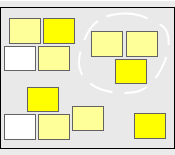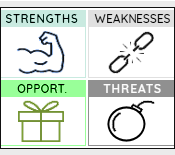

Continuous Improvement Toolkit
Effective Tools for Business and Life!
Brainstorming: A Key Technique for Idea Generation and Problem Solving

- 6 MINUTES READ
Also known as Idea Generation, Ideation, Brain-dumping, Brain Writing and Idea Writing.
Variants include Nominal Group Technique, Lateral Thinking, Delphi Technique, Mind Mapping, Six Thinking Hats and SCAMPER.
Brainstorming is a widely used creativity technique designed to generate and collect multiple ideas on a specific topic. It aims to produce as many ideas as possible within a short period of time. It is so popular as a tool for gathering data and ideas and an effective method for exploring problems and generating solutions. In a brainstorming session, participants are encouraged to share their thoughts spontaneously without judgment. This ensures that ideas are freely expressed and evaluated only after the brainstorming session ends.
One of the core principles of brainstorming is to stimulate creativity by allowing participants to propose ideas freely, without worrying about whether the ideas make sense. Logical thinking can hinder creativity. So, participants are encouraged to suspend their judgment and allow their thoughts to flow. This can spark creativity, challenge assumptions, and lead to innovative solutions that would not emerge from traditional thinking.
This results in a list of ideas that might contain unconventional, illogical, and surprising ideas alongside more obvious and practical ones. Once the brainstorming session concludes, the group can organize and evaluate these ideas using tools like affinity diagrams and prioritization matrices .
Creativity can be enhanced, and a broader range of ideas can be generated by bringing together the process players, experts, cross-functional teams, and various levels within the organization, which allows to capture a wide range of impressions and experiences.
Brainstorming is applicable in various environments. It is most commonly used to generate a wide variety of ideas in a short time. It is especially useful in scenarios where creative thinking is desired, or when the participation of the entire group is needed. In Lean Six Sigma projects, brainstorming is a key tool and often used to identify potential causes of problems alongside techniques such as the 5 Whys and fishbone analysis .
Brainstorming is also useful alongside strategic planning tools such as SWOT analysis and force field analysis . It can be used for many purposes beyond problem-solving and strategic planning. In project management, for example, it helps in setting project goals and identifying potential project risks . It is also an effective way to gather input and feedback from customers and employees to continuously improve processes and overall satisfaction.
Facilitation of Brainstorming Sessions
Successful brainstorming sessions require effective facilitation. These sessions are typically conducted by independent facilitators to ensure they run smoothly. The role of the facilitator is to create a climate of trust and confidence and encourage participants to share ideas freely. Facilitators should also ensure that the ideas are captured and recorded visibly, often on flipcharts or whiteboards. When the flow of ideas slows down, they should ask prompting questions to re-energize the group.
The facilitator must also manage the dynamics of the group and ensure that everyone participates and that no one feels left out. This is particularly helpful for participants who might be hesitant to share their ideas. By promoting an inclusive atmosphere, the facilitator maximizes the collective creativity of the group.
The facilitator may need to separate the group into smaller teams to allow individuals to speak up and contribute.
Common Brainstorming Methods
There are various brainstorming methods available, each suited to different situations and needs. Some of the most common techniques include:
Roundtable brainstorming , where participants share ideas in turn. This ensures that everyone contributes but may feel intimidating to some.
Free form brainstorming , where participants share ideas spontaneously in no particular order. This method is less structured but requires more careful facilitation to avoid losing focus.
Individual brainstorming , where participants develop ideas independently before sharing them with the group. This method allows for deeper personal reflection before group discussion.
After brainstorming, a key challenge is handling the large number of ideas generated. The goal is to reduce them to a more focused and manageable set for further evaluation. Techniques such as multi-voting can be used to narrow down the options. Participants vote on their preferred ideas, and the highest-ranking ones are further evaluated. Additionally, ideas can be ranked based on factors such as feasibility, cost, or time to implement. This helps prioritize the most viable solutions.
How to Facilitate a Brainstorming Process
A typical brainstorming process is divided into three main stages:
- Generating ideas.
- Organizing the ideas.
- Evaluating the ideas.
The following points outline how to facilitate a brainstorming process within a team setting:
- With your team, present the question and define the problem clearly.
- Capture as many ideas as possible using one of the brainstorming methods.
- Record the ideas on a visible medium such as a flipchart or whiteboard.
- Continue capturing ideas until the team runs out of ideas.
- Lead the team to group the ideas into categories that make sense.
- Narrow down and prioritize the ideas based on agreed criteria.
- Ask the team to vote on their preferred ideas.
- Consider the options with the highest ranking.
- Record and preserve all ideas for future reference.

Ground Rules for Brainstorming
For a brainstorming session to succeed, clear ground rules must be set and shared. Some of the rules may be:
- Share all ideas that come to mind. The more ideas there are, the better it will be.
- Write down everything that is said.
- Don’t criticize or evaluate during idea generation.
- Avoid making comments, asking questions, or engaging in discussions during idea generation.
- Focus on quantity over quality, even if some ideas seem illogical or unconventional.
- Build on each other’s ideas.
The following is a visual representation of a brainstorming exercise conducted to explore new ways to enhance employee engagement and motivation in a workplace. The text emerging from the center represents the ideas generated by the participants.
Brainstorming doesn’t have to be limited to groups; it can also be conducted for personal purposes. Personal brainstorming is useful for problem-solving, goal setting, and idea generation. Techniques like walking or disconnecting from distractions can help boost creativity when brainstorming alone.
Wrapping Up
Brainstorming is a powerful tool for generating creative ideas and engaging teams in collaborative problem-solving. By encouraging spontaneous idea sharing and carefully managing the process, individuals and teams can explore new possibilities and develop innovative solutions. Brainstorming, therefore, plays an important role in promoting creativity, improving collaboration, and increasing the chances of successful solutions.
Kubiak, T. M. (2012). The Certified Six Sigma Master Black Belt. Infotech.
Krajewski, L., Ritzman, L., Malhotra, M. (2018). Operation Management: Processes and Value Chains. Pearson.
Brook, Q. (2020). Lean Six Sigma and Minitab: The Complete Toolbox Guide for Business Improvement.
A Guide to the Project Management Body of Knowledge. (2013). Project Management Institute, Inc.
Other Formats
Infographic
Do you want to use the slides in your training courses?
Brainstorming Training Material – $18.85
Related Articles
Mind Mapping

Fishbone Diagram

Affinity Diagram

Related Templates

SWOT Analysis

Written by:
CIToolkit Content Team

IMAGES
VIDEO
COMMENTS
Brainstorming is a method for producing ideas and solving problems by tapping into creative thinking. Brainstorming usually takes place in an informal, relaxed environment, where participants are encouraged to share …
Unlock problem-solving potential with proven brainstorming examples and techniques for effective brainstorming sessions.
Brainstorming is not only good for problem-solving. It also allows employees and team members to understand how the people around them think. It helps the team get to know each …
Incorporating diverse brainstorming techniques such as mind mapping, SCAMPER, and round robin can unlock creative problem-solving potential. Facilitating …
Problem-framing challenges you to pinpoint the core problem that you’re solving for (for example, improving collaboration between your marketing and sales teams) and then draft a …
The answer lies in the concept of efficient brainstorming techniques. In this article, you’ll find a step-by-step guide, telling you all you need to know about brainstorming to make problem-solving decisions more efficiently, boosting …
Brainstorming for questions, rather than answers, helps you avoid group dynamics that often stifle voices, and it lets you reframe problems in ways that spur breakthrough thinking.